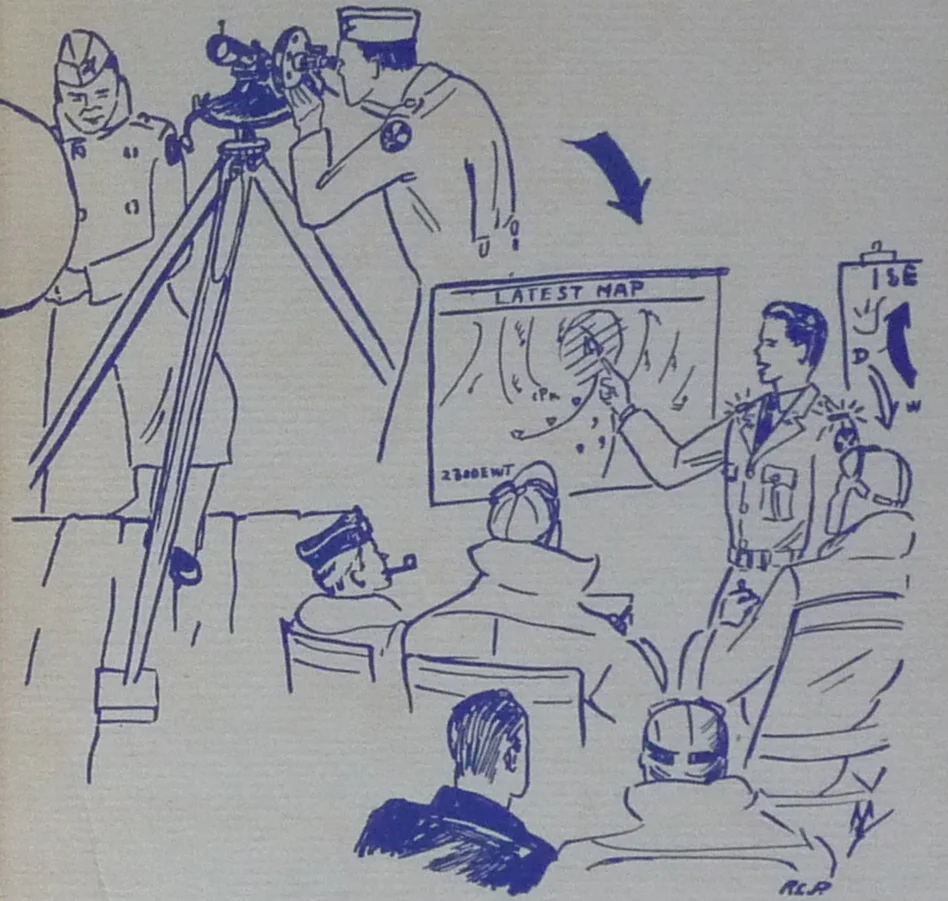Weather Cadet Generation: Maud E. Greenwood
The woman at far left is likely Maud Greenwood, learning about the University of Chicago’s mobile meteorological laboratory onboard the “Dude Fisherman,” a 45-foot cruiser that sailed Lake Michigan. September 1943. Image Credit: University of Chicago Photographic Archive, apf3-02883, Special Collections Research Center, University of Chicago Library.
Thousands of young people learned meteorology during World War II. This series profiles members of the “Weather Cadet Generation” who had remarkable postwar careers. (Read the series introduction.)
Like the future inventor of Cliffs Notes, Maud Greenwood learned from some of the world’s leading minds in meteorology at the University of Chicago. The Hackensack, NJ native and 1935 alumna of Juniata College was one of the two-dozen Women Accepted for Volunteer Emergency Service (WAVES) sent to Chicago in September, 1943. She was commissioned as a US Navy lieutenant when she graduated the day before D-Day.
The Navy posted new WAVES graduates from the training programs at Chicago, MIT, and UCLA to San Francisco’s Moffett Field and Naval Air Station San Diego to practice operational forecasting under supervision. Greenwood and the other WAVES supported blimps flying anti-submarine patrols, paying particular attention to fog and offshore wind conditions.
A squadron of anti-submarine blimps form up over Moffett Field during World War II. These long endurance aircraft needed careful meteorological support. I borrowed this image from http://www.warwingsart.com/LTA/zp-32.html, which credits the Moffett Field Historical Society.
Greenwood was next assigned to the Naval Air Training Base at Corpus Christi, Texas. To help trainee pilots remember her forecasts, she illustrated them with cartoons. “The commander of the aerology office saw my drawings, liked them and put me to work painting weather pictures on the walls,” she remembered 50 years later. “Next thing you know, I’m on my way to Washington D.C. as a meteorologist/artist to help with aerological publications.”
Cartoons and other visual aids were crucial parts of meteorological training during the war, helping pilots to understand complex ideas about the weather that could save their lives during missions. Wonderful and evocative cartoons can be found throughout Navy training materials, drawn by unusually talented people like Greenwood.
Most cartoons drawn for US Navy aerology manuals were unsigned. This representative image comes from Aerology for Pilots (Government Printing Office: U.S. Navy, 1943).
While the war had created manpower shortages that women ably filled, sexism could thrive amidst the postwar labor glut. “I very much wanted a career in forecasting after WWII,” Greenwood wrote. “The airlines were advertising for meteorologists. I applied and was told that a woman could not deal with pilots and dispatchers,” although that is exactly what she and dozens of other women had been doing throughout the war. Instead she was offered a job as a map plotter, a sub-professional position beneath her experience with lower pay and fewer prospects for advancement.
Driven from meteorology by discrimination, Greenwood put her scientific and artistic talents to work as a medical illustrator, working first for the Veteran’s Administration and then as a professor of anatomy at Merritt College in California. She wrote and illustrated two books, An Illustrated Approach to Medical Physics (1963, 1966) and Medical Physica (1968). “It has been my experience,” she prefaced her first book, “that illustrations have been of great value in simplifying the principles applying to practical situations.” After retiring in 1979, Greenwood ran her own business in commercial and fine art.
Some images from An Illustrated Approach to Medical Physics:
Learn More:
- J.M. Lewis, “WAVES Forecasters in World War II (with a Brief Survey of Other Women Meteorologists in World War II)” Bulletin of the American Meteorological Society 76, 11 (November 1995): 2187-2202.
- Roger Turner, Weathering Heights: The Emergence of Aeronautical Meteorology as an Infrastructural Science (Ph.D. Dissertation, University of Pennsylvania, 2010): chapter 4, pp 137-194.
- Maud E. Greenwood, An Illustrated Approach to Medical Physics 2nd Edition (Philadelphia: F. A. Davis Company, 1966).














